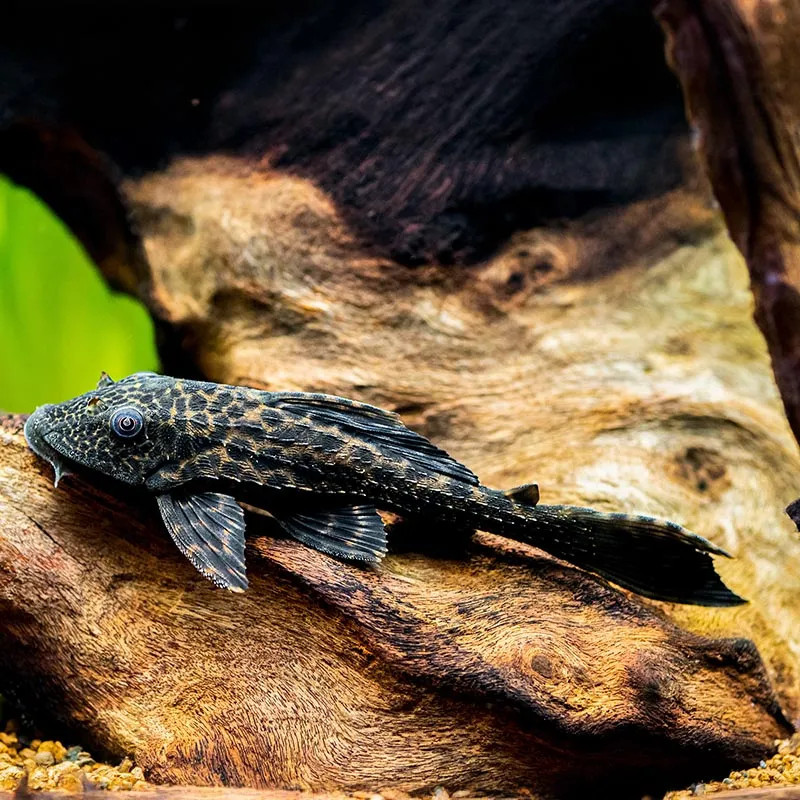Stocks Available
Albino Bushynose Pleco - Small
SKU:118335
ALBINO BRISTLENOSE PLECO
2 INCH

Stock Available
Introduction: • Common Names: Trinidad Pleco, Black-Spotted Catfish • Natural Habitat: Native to the freshwater rivers and streams of Trinidad and other regions in the Caribbean, often found in areas with slow currents and abundant vegetation. Physical Characteristics: • Appearance: Features a robust, elongated body covered in dark brown to black coloration, adorned with distinctive white to yellow spots or markings; the dorsal fin is tall and spiny. • Size: Typically reaches lengths of 6-8 inches (15-20 cm) in captivity, but can grow larger in the wild. • Lifespan: Can live for 10-15 years with proper care and a suitable environment. Habitat Requirements: • Tank Size: A minimum tank size of 50 gallons is recommended to accommodate their growth and activity level. • Water Conditions: o Temperature: Prefers a water temperature range of 75-82°F (24-28°C). o pH: Thrives in slightly acidic to neutral pH levels, ideally between 6.5 and 7.5. • Aquascaping: Requires plenty of hiding places such as caves, driftwood, and dense plant cover to feel secure and reduce stress. Diet: • Primary Diet: Omnivorous; feeds on algae, plant matter, and detritus in their natural habitat. • Supplemental Feeding: Provide high-quality sinking pellets, algae wafers, and fresh vegetables like zucchini, spinach, or cucumber. • Feeding Frequency: Feed once or twice a day, ensuring they have access to food without overfeeding. Compatibility: • Temperament: Generally peaceful but can display territorial behavior, particularly during breeding or in smaller spaces. • Suitable Tank Mates: Compatible with other peaceful fish of similar size, such as tetras, rasboras, and larger community fish. • Incompatibilities: Avoid aggressive or fin-nipping species that may harass the pleco. Care Level: • Difficulty: Moderate; they require stable water conditions and a varied diet to thrive. • Health Monitoring: Regularly observe for signs of disease, including skin lesions or changes in behavior, to ensure their well-being. Breeding: • Breeding in Captivity: Possible but not common; requires specific conditions and can be challenging. • Spawning: Egg layers; typically lay eggs in caves, where the male guards and protects them until they hatch. Economic Considerations: • Market Demand: The Trinidad Pleco is sought after for its unique appearance and algae-eating capabilities. • Wholesale/Retail Pricing: Generally available at moderate prices in the aquarium trade, reflecting its popularity among enthusiasts. Sustainability and Conservation: • Wild Population: Currently not classified as endangered, but habitat degradation and overcollection may pose risks in the future. • Aquaculture Efforts: Limited success in breeding in captivity, with many specimens still wild-caught. • Regulations: Ensure compliance with local and international laws regarding the collection and trade of freshwater fish. Conclusion: The Trinidad Pleco is a stunning and functional addition to community aquariums, known for its algae-eating abilities and unique patterning. With appropriate care and attention to their habitat requirements, these fish can thrive, bringing beauty and balance to aquatic environments.
Data sheet
4 other products in the same category: